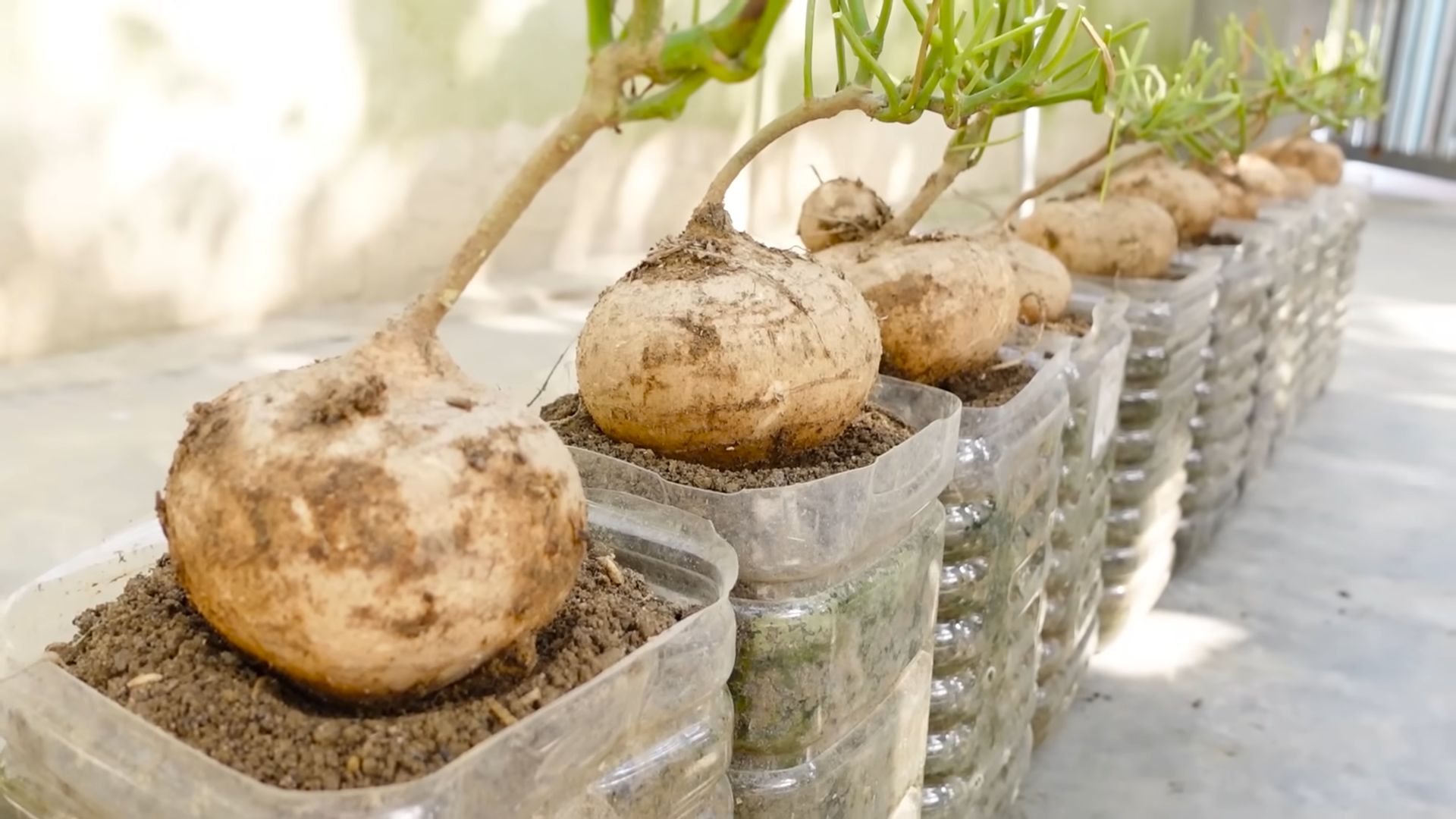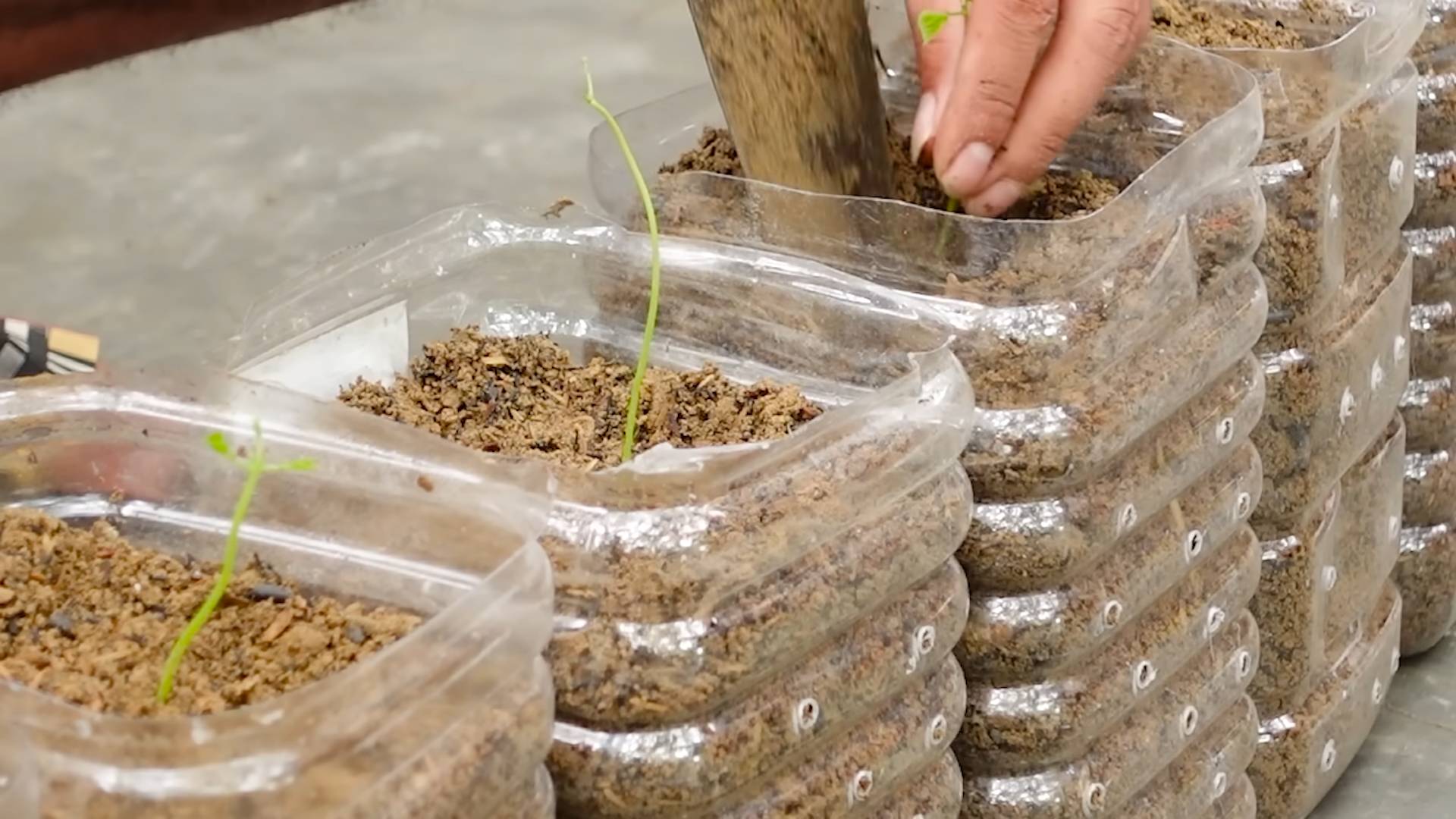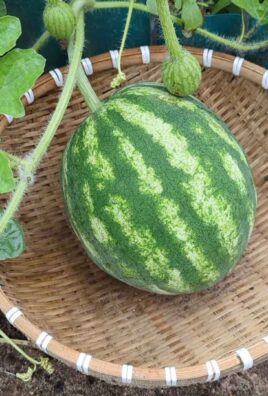Growing Sweet Jicama at Home might seem like a challenge, especially if you’re not familiar with this delicious and crunchy root vegetable. But trust me, with a few simple tricks and a little patience, you can absolutely cultivate your own supply of fresh jicama right in your backyard!
Jicama, also known as the Mexican turnip, has a rich history deeply rooted in Central and South American cultures. For centuries, it’s been a staple ingredient, enjoyed raw in salads, cooked in stir-fries, and even used in traditional medicine. Imagine bringing that vibrant history and flavor to your own table, all thanks to your own gardening efforts!
Why should you embark on this DIY adventure? Well, for starters, homegrown jicama tastes incredibly fresh and sweet compared to store-bought varieties. Plus, you’ll have complete control over the growing process, ensuring it’s free from harmful pesticides and chemicals. More importantly, growing sweet jicama at home is a rewarding experience that connects you with nature and provides a sense of accomplishment. I’m excited to share some easy-to-follow tips and tricks that will help you succeed, even if you’re a beginner gardener. Get ready to enjoy the crisp, refreshing taste of homegrown jicama!

Growing Sweet Jicama at Home: A Beginner’s Guide
Hey there, fellow gardening enthusiasts! Ever wanted to try growing something a little different, something that adds a unique crunch and sweetness to your salads and snacks? Well, look no further than jicama! This root vegetable, also known as Mexican turnip or yam bean, is surprisingly easy to grow at home, and I’m here to guide you through the entire process. Trust me, the satisfaction of harvesting your own fresh jicama is totally worth it.
What You’ll Need
Before we dive in, let’s gather our supplies. Here’s a list of everything you’ll need to successfully grow jicama:
* Jicama seeds: You can find these online or at your local garden center. Make sure to choose a variety suited to your climate.
* Seed starting trays or small pots: These will be used to germinate the seeds indoors.
* Seed starting mix: A light, well-draining mix is essential for healthy seedling development.
* Larger pots or a garden bed: Jicama needs plenty of space to grow, so choose accordingly.
* Well-draining soil: Jicama thrives in soil that’s rich in organic matter and drains well.
* Compost or aged manure: To enrich the soil and provide essential nutrients.
* Trellis or support structure: Jicama vines can get quite long, so a trellis will help keep them off the ground.
* Watering can or hose: For regular watering.
* Gardening gloves: To protect your hands.
* Optional: Fertilizer specifically formulated for root vegetables.
Starting Your Jicama Seeds Indoors
Since jicama requires a long growing season (around 150-200 days), starting the seeds indoors is highly recommended, especially if you live in a cooler climate. Here’s how I do it:
1. Soaking the Seeds: Jicama seeds have a tough outer shell, so soaking them in warm water for 24 hours before planting will significantly improve germination rates. I usually put them in a small bowl and cover them with water, making sure they’re fully submerged.
2. Preparing the Seed Starting Trays: Fill your seed starting trays or small pots with seed starting mix. Gently press the mix down to remove any air pockets.
3. Planting the Seeds: Make a small indentation (about 1/2 inch deep) in the center of each cell or pot. Place one or two jicama seeds in each indentation and cover them with the seed starting mix.
4. Watering: Gently water the seed starting mix until it’s evenly moist but not soggy. I like to use a spray bottle to avoid disturbing the seeds.
5. Providing Warmth and Light: Jicama seeds need warmth to germinate. Place the seed starting trays in a warm location, such as on top of a refrigerator or near a heat vent. You can also use a heat mat specifically designed for seed starting. Once the seedlings emerge, they’ll need plenty of light. Place them under grow lights or in a sunny windowsill. If using a windowsill, rotate the trays regularly to ensure even growth.
6. Maintaining Moisture: Keep the seed starting mix consistently moist but not waterlogged. Check the moisture level daily and water as needed.
Transplanting Your Jicama Seedlings
Once your jicama seedlings have developed a few sets of true leaves (usually after about 4-6 weeks), they’re ready to be transplanted into larger pots or directly into your garden bed.
1. Hardening Off: Before transplanting, it’s crucial to harden off your seedlings. This process gradually acclimates them to outdoor conditions, reducing the risk of transplant shock. Start by placing the seedlings outdoors in a sheltered location for a few hours each day, gradually increasing the amount of time they spend outside over the course of a week.
2. Preparing the Soil: Jicama prefers well-draining soil that’s rich in organic matter. Amend your garden soil with compost or aged manure to improve its fertility and drainage. If you’re growing jicama in pots, use a high-quality potting mix.
3. Choosing a Location: Select a location that receives at least 6-8 hours of sunlight per day. Jicama needs plenty of sun to thrive.
4. Transplanting: Gently remove the seedlings from their seed starting trays or pots. Be careful not to damage the roots. Dig a hole that’s slightly larger than the root ball and place the seedling in the hole. Backfill with soil and gently firm it around the base of the plant. Space the plants about 12-18 inches apart.
5. Watering: Water the newly transplanted seedlings thoroughly.
Caring for Your Jicama Plants
Now that your jicama plants are in their permanent location, it’s time to provide them with the care they need to flourish.
1. Watering: Jicama needs consistent moisture, especially during hot, dry weather. Water deeply whenever the top inch of soil feels dry to the touch. Avoid overwatering, as this can lead to root rot.
2. Fertilizing: Jicama benefits from regular fertilization. Use a fertilizer that’s specifically formulated for root vegetables, following the instructions on the package. I usually fertilize every 2-3 weeks during the growing season.
3. Providing Support: Jicama vines can get quite long and heavy, so it’s important to provide them with a trellis or other support structure. This will help keep the vines off the ground and prevent the jicama roots from rotting.
4. Pinching Off Flowers: This is a crucial step for maximizing jicama root growth. Jicama plants produce beautiful purple flowers, but allowing them to bloom will divert energy away from root development. Pinch off the flowers as soon as they appear. I know it’s tempting to let them bloom, but trust me, you’ll be rewarded with larger, sweeter jicama roots.
5. Weed Control: Keep the area around your jicama plants free of weeds. Weeds compete with the jicama for nutrients and water.
6. Pest and Disease Control: Jicama is generally resistant to pests and diseases, but it’s still important to monitor your plants regularly. If you notice any signs of infestation or disease, take action promptly. Common pests that may affect jicama include aphids and spider mites. These can usually be controlled with insecticidal soap or neem oil.
Harvesting Your Jicama
The moment we’ve all been waiting for! Harvesting your own homegrown jicama is incredibly rewarding.
1. Timing: Jicama is typically ready to harvest about 150-200 days after planting. The exact timing will depend on your climate and the specific variety you’re growing. A good indicator that your jicama is ready to harvest is when the vines start to turn yellow and die back.
2. Harvesting: Carefully dig around the base of the plant to expose the jicama root. Gently loosen the soil around the root and lift it out of the ground. Be careful not to damage the root.
3. Cleaning: Brush off any excess soil from the jicama root.
4. Curing: Cure the harvested jicama in a cool, dry place for a week or two. This will help to improve its flavor and storage life.
5. Storing: Store cured jicama in a cool, dry place, such as a root cellar or refrigerator. Jicama can be stored for several months if properly cured and stored.
Enjoying Your Homegrown Jicama
Now that you’ve harvested your own jicama, it’s time to enjoy the fruits (or rather, roots) of your labor! Jicama is incredibly versatile and can be used in a variety of dishes.
* Raw: Jicama is delicious eaten raw. Simply peel and slice it into sticks or cubes and enjoy it as a snack or add it to salads. Its crisp texture and slightly sweet flavor make it a refreshing addition to any meal.
* Cooked: Jicama can also be cooked. It can be stir-fried, roasted, or added to soups and stews. When cooked, jicama retains its crisp texture and adds a subtle sweetness to dishes.
* Salads: Jicama is a popular ingredient in salads. It pairs well with other vegetables, fruits, and dressings.
* Snacks: Jicama sticks are a healthy and delicious snack. They can be dipped in hummus, guacamole, or other dips.
* Slaws: Jicama can be shredded and used in slaws. It adds a refreshing crunch to coleslaw and other slaw recipes.
Growing jicama at home is a fun and rewarding experience. With a little patience and care, you can enjoy fresh, delicious jicama from your own garden. Happy gardening!

Conclusion
So, there you have it! Growing sweet jicama at home is not only achievable, but it’s also a deeply rewarding experience that connects you to the food you eat in a profound way. Forget those bland, store-bought tubers that lack the vibrant sweetness and satisfying crunch of a homegrown jicama. This DIY trick, from seed to harvest, unlocks a world of flavor and freshness right in your own backyard (or even on your balcony!).
Why is this a must-try? Because you’re not just growing a vegetable; you’re cultivating a connection to nature, learning new skills, and ultimately, enjoying a superior product. The taste difference alone is enough to convince anyone. Imagine biting into a jicama that’s bursting with natural sweetness, a crispness that sings, and a subtle earthiness that only comes from being freshly harvested. It’s a culinary experience that store-bought jicama simply can’t replicate.
But the benefits extend beyond just taste. You’re also in control of the growing process, ensuring that your jicama is free from harmful pesticides and chemicals. You know exactly what went into nurturing your plant, giving you peace of mind and a healthier, more sustainable food source. Plus, the act of gardening itself is incredibly therapeutic, offering a chance to de-stress, connect with nature, and enjoy the satisfaction of watching something grow from a tiny seed into a bountiful harvest.
Looking for variations? Consider experimenting with different growing mediums. While we’ve outlined a successful method using well-draining soil, you could also explore hydroponics or container gardening techniques. For those in colder climates, starting your jicama indoors and transplanting it outdoors after the last frost is crucial. You can also try different trellising methods to maximize space and support the vines. Some gardeners even report success with growing jicama in large pots on sunny patios, proving that you don’t need a sprawling garden to enjoy this delicious root vegetable.
And don’t forget the culinary possibilities! While jicama is fantastic eaten raw in salads, slaws, and as a crunchy snack, it’s also incredibly versatile in cooked dishes. Try adding it to stir-fries, soups, or even grilling it for a smoky, sweet flavor. The possibilities are endless!
We wholeheartedly encourage you to give this DIY trick a try. Growing sweet jicama at home is an adventure, a learning experience, and a delicious reward all rolled into one. Don’t be intimidated by the process; with a little patience and care, you’ll be enjoying your own homegrown jicama in no time.
Most importantly, we want to hear about your experience! Share your photos, tips, and challenges in the comments below. Let’s create a community of jicama growers and learn from each other. What worked for you? What challenges did you face? What are your favorite ways to enjoy your homegrown jicama? Your insights will help others succeed and inspire even more people to embark on this rewarding journey. So, grab your seeds, get your hands dirty, and get ready to experience the joy of growing your own sweet jicama!
Frequently Asked Questions (FAQ)
What is the best time of year to plant jicama?
Jicama thrives in warm weather and requires a long growing season (at least 150 days). Therefore, the best time to plant jicama is in the spring, after the last frost has passed. In warmer climates with mild winters, you may be able to plant jicama in early spring or even late winter. If you live in a colder climate, starting your jicama seeds indoors 6-8 weeks before the last frost is highly recommended. This will give your plants a head start and ensure they have enough time to mature before the first frost of fall.
How much sunlight does jicama need?
Jicama needs plenty of sunlight to thrive. Aim for at least 6-8 hours of direct sunlight per day. If you’re growing jicama indoors, place it near a sunny window or use grow lights to supplement natural light. Insufficient sunlight can result in stunted growth and smaller tubers.
What kind of soil is best for growing jicama?
Jicama prefers well-draining soil that is rich in organic matter. Sandy loam soil is ideal, as it allows for good drainage and aeration. Before planting, amend your soil with compost or well-rotted manure to improve its fertility and drainage. Avoid heavy clay soils, as they can become waterlogged and hinder root development. If you have clay soil, consider growing jicama in raised beds or containers with a well-draining potting mix.
How often should I water my jicama plants?
Jicama needs consistent watering, especially during hot and dry periods. Water deeply whenever the top inch of soil feels dry to the touch. Avoid overwatering, as this can lead to root rot. During periods of heavy rainfall, you may need to reduce watering frequency. Mulching around your jicama plants can help retain moisture in the soil and reduce the need for frequent watering.
Do I need to fertilize my jicama plants?
Yes, jicama benefits from regular fertilization. Use a balanced fertilizer (e.g., 10-10-10) every 4-6 weeks during the growing season. You can also use organic fertilizers such as compost tea or fish emulsion. Avoid over-fertilizing, as this can lead to excessive foliage growth at the expense of tuber development.
How do I know when my jicama is ready to harvest?
Jicama typically takes 150-200 days to mature. You can harvest your jicama when the tubers are about 4-6 inches in diameter. To check for maturity, gently dig around the base of the plant and feel for the size of the tuber. If it’s large enough, carefully dig it up. The leaves may start to yellow and die back as the plant matures, which is another sign that it’s ready to harvest.
Can I eat the leaves or seeds of the jicama plant?
No, the leaves and seeds of the jicama plant are toxic and should not be consumed. Only the tuberous root is edible.
How do I store jicama after harvesting?
After harvesting, brush off any excess soil and store your jicama in a cool, dry place. A root cellar or refrigerator is ideal. Jicama can be stored for several weeks or even months if stored properly. Avoid storing jicama in a humid environment, as this can cause it to rot.
My jicama plant is producing flowers. Should I remove them?
Yes, it’s generally recommended to remove the flowers from your jicama plant. Allowing the plant to flower and produce seeds will divert energy away from tuber development, resulting in smaller and less flavorful jicama. Pinch off the flowers as soon as they appear to encourage the plant to focus its energy on growing the tuber.
What are some common pests and diseases that affect jicama?
Jicama is relatively pest-resistant, but it can be susceptible to aphids, spider mites, and nematodes. Regularly inspect your plants for signs of infestation and take appropriate action if necessary. Insecticidal soap or neem oil can be used to control aphids and spider mites. Nematodes can be controlled with soil amendments such as compost and by practicing crop rotation. Jicama is also susceptible to fungal diseases such as root rot, especially in poorly drained soil. Ensure good drainage and avoid overwatering to prevent fungal problems.
Can I grow jicama in containers?
Yes, you can grow jicama in containers, but you’ll need a large container (at least 20 gallons) to accommodate the tuber’s growth. Use a well-draining potting mix and provide plenty of sunlight and water. Container-grown jicama may not grow as large as those grown in the ground, but you can still enjoy a decent harvest.
Is growing sweet jicama at home organic?
Whether your jicama is organic depends on the methods you use. By avoiding synthetic pesticides and fertilizers, and focusing on soil health through composting and other natural practices, you can absolutely grow organic jicama at home. Look for certified organic seeds to ensure a truly organic start.





Leave a Comment